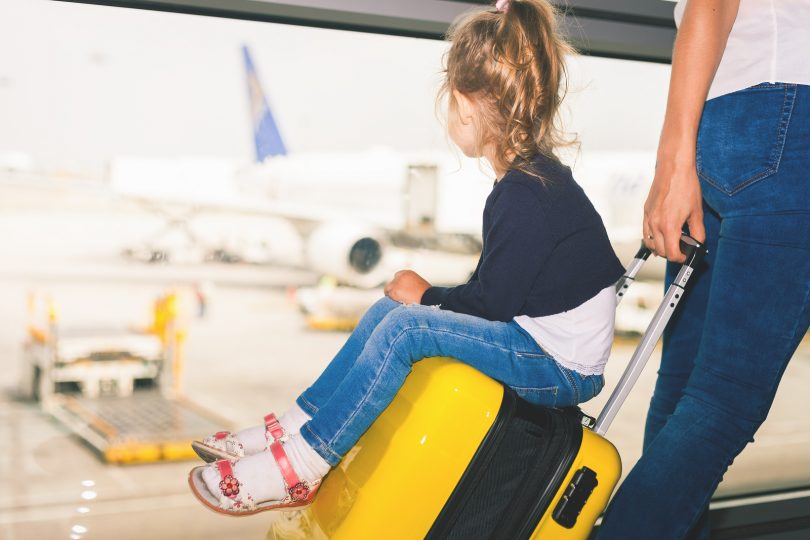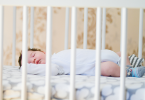Traveling during the holiday season can be stressful enough.
Traveling with a young child—or children? Cue the Tylenol.
Help avoid the potential headaches of traveling this winter with your kids, with these pointers from Renee McCabe of Safe Kids Greater Augusta.
In General
As a start, ease the stress by keeping a list of items you need to bring—and keep that list in one easy-to-remember place, like the refrigerator door or your bedside table, so you can add to it as items come to mind. As you pack, you can check off items so you don’t have to keep asking yourself, “Did I remember that?”
Along with the basics—like weather-appropriate clothes and shoes, toiletries, toys and other distraction items, gifts, diapers and other baby/toddler items, any food, including extra formula, bottled water and snacks—don’t forget:
- Phone chargers, both for the wall and the car
- Medicine, including basics like Tylenol, Benadryl and cough drops
- Sunglasses and sunscreen, whether you’re traveling to a snowy or warm and sunny destination
- Lip moisturizer for cold destinations
- Earbuds if you plan to have your child watch videos or listen to music while traveling
Traveling by Car
We all know how important it is for our children to be in the correct child safety seat or booster seat for their age and weight. It’s just as important for us to make sure the car is serviced appropriately before we head off on a long trip.
So doublecheck the oil and other fluids, including windshield wiper fluid (bring extra if you’ll be driving through snow); make sure tires are properly inflated and have your spare and other tools, including jumper cables, in the trunk; and get any other repairs needed before you travel.
In the car, make sure your emergency kit includes a flashlight, flares, ice scrapers, snacks and blankets in case—worst case scenario—you get stuck somewhere. Here’s an easy tip: You can use a rubber mat under your wheels to help get your car out of snow, and a small shovel might be handy too, especially to clear out any snow from your exhaust pipe.
Everything you pack in the car should also be stowed away safely in the trunk or wedged in tightly so items won’t move, in case you do have an accident. Any loose items in the car could fly around during a crash and hurt you badly. This even includes something as light as a box of Kleenex. “You have to take into account the weight and multiply it by the speed you’re traveling,” said McCabe. “If a full box of Kleenex weighs a half-pound and you’re driving 70 miles per hour, that’s 35 pounds of crash force in an accident.”
If you’re traveling for several hours, those earbuds are a must, as are snacks that won’t leave crumbs everywhere. “That way everybody can do their own thing, and you can keep your sanity,” said McCabe.
And back to that car seat: Make sure to buckle your child up without that bulky winter coat. Instead, drape the coat or a blanket over him or her. Otherwise, you won’t be able to adjust the straps well, and since puffy items tend to compress during an accident, your child won’t be secured tightly enough.
Traveling by Plane
Everyone wonders this: During an airplane crash, would a car seat even matter?
The answer: Yes. “Everyone asks about that, but there are stories where children survived a plane crash because they were in a car seat, and it cocooned them during the crash,” said McCabe. Car seats also help cushion kids in the event of severe turbulence during the flight.
Yes, it seems like a hassle, but you can invest in an inexpensive, lighter-weight and narrower car seat that can serve as your backup/travel seat. “One caveat is to make sure the seat is FAA-approved,” said McCabe. “You’ll find that on the labeling of the car seat.”
Plus, even if you think you can rely on car seats provided by Uber drivers or even rent one at your destination, do you know how clean that seat really is? Or if it has ever been in an accident? “Realistically, sometimes that has to be your option,” said McCabe. “But when you can, it’s best to travel with your own seat.”
Booster seats, though, are a different story. Because they’re designed only for use in cars, with a lap and shoulder belt, they shouldn’t be used on planes. But you should certainly pack them in your luggage and use them at your destination.
Don’t forget to add these to your packing list: disinfecting wipes to clean off tray tables and seats, along with a pacifier, bottle or gum (depending on your child’s age) to encourage your child to swallow during takeoff and landing and ease up the pressure in their ears.
Finally, communal traveling methods like planes, trains and buses can also be flu hot spots. Ask your doctor about getting a flu shot prior to your departure date.
Travel Safe
McCabe recently took a car trip to the D.C. area with her two kids over Thanksgiving break. It took 11 hours, with plenty of snacks, screen time, pit stops and more to get them through.
“Holidays can be both joyful and stressful,” she said. “But even if travel doesn’t go the way you imagined, a little planning can help ease the bumps.”




